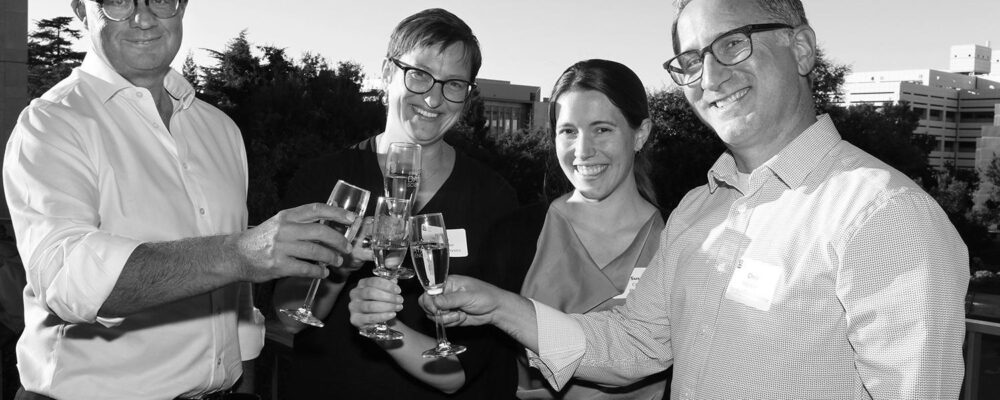Nuclear energy is poised to become the future of energy, and the global race to lead this industry is intensifying. But how can the United States compete and invigorate its nuclear energy industry, particularly amid the explosive growth of artificial intelligence? Stanford students Mandy Alevra, Nuri Capanoglu, Elena Kopstein, and Jackson Painter have ideas.
Last week, they traveled to the nation’s capital to present proposals they developed in the fall quarter course MS&E 296: Technology, Innovation and Great Power Competition, which explored how new technologies pose challenges and create opportunities for the U.S. to compete more effectively with global rivals.
Tarun Chhabra, ’02, is an attorney who currently serves as senior director for technology and national security at the National Security Council (NSC). After learning of the students’ work, he invited them to Washington, D.C., to share their proposals.
With support from the Stanford Gordian Knot Center for National Security Innovation, Alevra, Capanoglu, Kopstein, and Painter presented to Chhabra and others from the NSC at the White House on Dec. 10. They also met with nuclear power experts from the Nuclear Energy Institute and Clear Path. Reception from their presentation was positive, with attendees expressing interest in their memorandum.
The AI energy challenge
The students’ project examined how the exponential growth of AI could strain the nation’s power supply. That’s because future training of large language models, or LLMs, will require an enormous amount of energy, far more than America’s current energy sources can manage.
“The projected power needs for the next 10 years could destroy our grid if we don’t upgrade our energy,” said Painter. “Nuclear is a great solution to meet the growing demands for energy – and clean energy – that people want.”
The students developed three policy recommendations they said could help the U.S. effectively transition to nuclear energy.
Policy proposals for a nuclear transition
The first is to expedite the nuclear permitting process by creating a centralized database for all the permitting codes associated with nuclear energy. Kopstein noted that in China, permitting construction of a small modular reactor (which produces nuclear energy) takes just one to three years, while in the U.S. the process takes five to 10.
“With a centralized database, AI integration, and usable interface, we projected that the permitting timeline could be reduced by 15 to 25 percent and the costs associated with permitting could be reduced by 20 to 30 percent,” Kopstein said.
Their second proposal aims to reduce the risk of investing in nuclear technology. A recent case study of construction of nuclear power plants in Georgia found that costs ran significantly over initial projections, leading some private equity firms to eschew such ventures.
“We recommended providing cost overrun insurance that developers can buy into so the government can help [cover] some of the risk and incentivize private investment,” Painter said. “The best way to do this would be through the loan program office in the Department of Energy.”
Lastly, they encouraged the U.S. to increase exports of nuclear energy to compete with Russia and China, which dominate the global market. Alevra explained that China leads development of nuclear technologies, including the most advanced reactor designs. Meanwhile, Russia is the leading producer of the uranium fuel that powers reactors, creating a global dependence on its exports.
“Both of these countries, which are competitors to the U.S., are ahead in terms of construction, technology, and fuel production,” Alevra said. “So, the U.S. needs to improve its policies to stay competitive.”
Capanoglu noted that both China and Russia utilize an exporting process that is state-run and therefore streamlined and hassle-free for countries buying their nuclear products and services. But in the U.S., the process is a patchwork of contractors that design, build and operate nuclear reactors, produce fuel, and remove nuclear waste. China and Russia offer what Capanoglu called “packaged deals” for the same work.
“We propose to have a whole-of-government approach where you bring in different agencies and stakeholders that have some say in this matter of exporting, including the U.S. departments of State, Energy, and Commerce, and the National Security Council,” Capanoglu said. “Then bring in private companies to offer similar packages that compete with Russia’s and China’s.”
The students noted that improving America’s transition to nuclear energy is a bipartisan issue, with strong support from both the current and incoming White House administrations and both chambers of Congress.
“I have so much gratitude for the teaching team in this class, and the general resources that Stanford provides, because this was truly a once-in-a-lifetime experience,” Kopstein said. “We’re so grateful to Stanford, the Gordian Knot Center, and the MS&E department for making this possible.”
“Stanford University, officially Leland Stanford Junior University, is a private research university in Stanford, California. The campus occupies 8,180 acres, among the largest in the United States, and enrols over 17,000 students.”
Please visit the firm link to site






